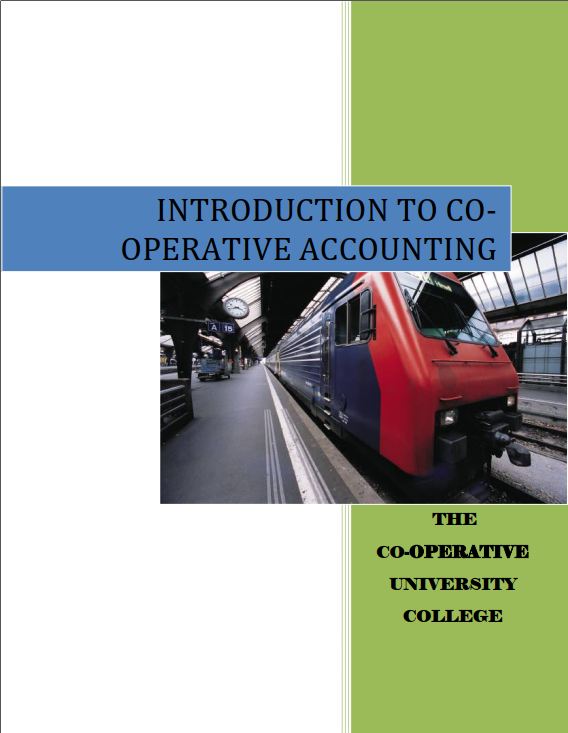
LESSON ONE: INTRODUCTION TO CO-OPERATIVE ACCOUNTING
1.1 Overview of the Co-operative Movement
1.2 Specific Objectives
1.3 Overview of the Co-operative Movement
1.4 Provisions of co-operative Societies Act Relating to Co-operative Accounting
1.5 Definition of co-operative accounting
1.5.1 Requirements of the Society in relation to Co-operative Accounting
1.5.2 Accounting concepts
1.5.3 Accounting policies
1.5.4 Accounting principles
1.6 Development of co-operative accounting
1.7 Objectives of co-operative accounting
1.8 Importance of co-operative accounting
1.9 Summary
1.10 Self Assessment Questions
LESSON TWO: STANDARDISED ACCOUNTING SYSTEM (SAS)
2.1 Introduction
2.2 Specific Objectives
2.3 Definition of Standardized Accounting System (SAS)
2.4 Objectives of Standardized Accounting System
2.5 Components of standardized Accounting System
2.6 Advantages of standardized Accounting System
2.7 Disadvantages of Standardized Accounting System
2.8 Summary
2.8 Self Assessment Questions
LESSON THREE: THE ACCOUNTING PLAN
3.1 Introduction
3.2 Specific Objectives
3.3 Purpose of an Accounting Plan
3.4 Numbering System
3.5 Activity Numbering System
3.5.1 Activity Group Identification Number
3.5.2 Individual Activity Identification Number
3.6 Numbering of Classes of Accounts
3.7 Numbering of Group of Accounts
3.8 Numbering of Individual Accounts
3.9 Numbering the Surplus and Loss Account
3.10.1 Assets Accounts
3.10.2 Liabilities Accounts
3.11 Summary
3.12 Self Assessment Questions
LESSON FOUR: MEMBER TRANSACTION SYSTEM (MT-SYSTEM)
4.1 Introduction
4.2 Specific Objective
4.3 Member Transactions System (MT)
4.4 Objectives of Member Transactions System
4.5 Types of MT-System
4.6 MT-Coffee System
4.7 Forms and Equipment used for Recording
4.8 Procedure for Produce Recording
4.9 Closing the Factory Journals
4.10 Intake Reconciliation
4.11 Reconciliation Procedure
4.12 Gross Payment Calculation
4.13 Payment Calculation
4.14 Net Payment Journal
4.14 MT SACCO
4.15 MPA card
4.16 Case study of Ukulima Sacco
4.17 Recording of Cash and Non- cash transactions
LESSON FIVE: LOOSE-LEAF LEDGER AND CARD SYSTEM
5.1 Introduction
5.2 Specific Objectives
5.3Definition of a Loose Leaf ledger
5.4 Advantages of loose leaf ledger system
5.5 Disadvantages of loose leaf ledger system
5.6 Cash Journal
5.7 The Journal/ work sheet for Trial balances
5.9 Summary
5.10 Self Assessment Questions
LESSON SIX: REGISTERS
6.1 Introduction
6.2 Specific Objective
6.3 Identify major registers used in co-operative organisation
6.4 Features and Functions of registers
6.5 Recording of given information into the registers
6.6 Summary
6.7 Self Assessement Questions
LESSON SEVEN: BUDGETING AND BUDGETARY CONTROL
7.1 Introduction
7.2 Specific Objective
7.3Define budget
7.4 Types of a budget
7.5 Features of a Good Budget
7.6 Importance of Budgeting
7.7 Reasons for Preparing a Budget
7.8 The Budgeting Process
7.9 Five steps in budgeting
7.10 Budgeting Limitation
7.11 Budgeting & Budgetary Control in Co-operatives
7.12 Budgeting for Secondary Activities
7.12 Summary
7.13 Self Assessment Questions
LESSON ONE: INTRODUCTION TO CO-OPERATIVE
ACCOUNTING
